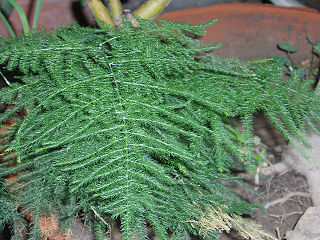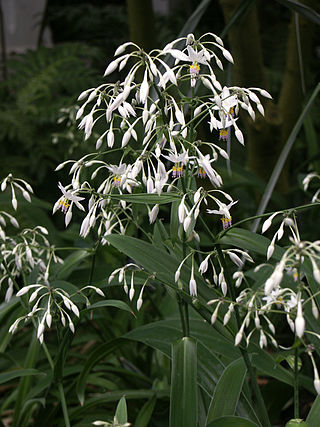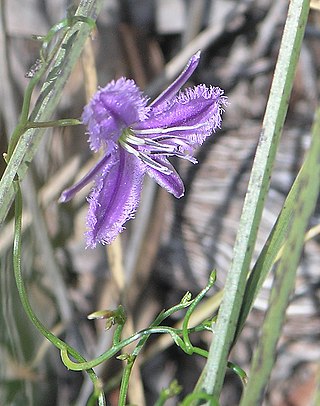
Asparagus is a genus of flowering plants in the family Asparagaceae, subfamily Asparagoideae. It comprises up to 300 species. Most are evergreen long-lived perennial plants growing from the understory as lianas, bushes or climbing plants. The best-known species is the edible Asparagus officinalis, commonly referred to as just asparagus. Some other members of the genus, such as Asparagus densiflorus, are grown as ornamental plants.

Nolinoideae is a monocot subfamily of the family Asparagaceae in the APG III system of 2009. It used to be treated as a separate family, Ruscaceae s.l. The family name is derived from the generic name of the type genus, Nolina.

Hyacinthoides is a genus of flowering plants in the family Asparagaceae, known as bluebells.

Arthropodium is a genus of herbaceous perennial plants in the subfamily Lomandroideae of the family Asparagaceae. Members of this genus are native to Australia, New Zealand, New Caledonia, and Madagascar.
Botanical nomenclature is the formal, scientific naming of plants. It is related to, but distinct from taxonomy. Plant taxonomy is concerned with grouping and classifying plants; botanical nomenclature then provides names for the results of this process. The starting point for modern botanical nomenclature is Linnaeus' Species Plantarum of 1753. Botanical nomenclature is governed by the International Code of Nomenclature for algae, fungi, and plants (ICN), which replaces the International Code of Botanical Nomenclature (ICBN). Fossil plants are also covered by the code of nomenclature.

Asparagaceae, known as the asparagus family, is a family of flowering plants, placed in the order Asparagales of the monocots. The family name is based on the edible garden asparagus, Asparagus officinalis. This family includes both common garden plants as well as common houseplants. The garden plants include asparagus, yucca, bluebell, and hosta, and the houseplants include snake plant, corn cane, spider plant, and plumosus fern.

Lomandroideae is a subfamily of monocot flowering plants in the family Asparagaceae, order Asparagales, according to the APG III system of 2009. The subfamily name is derived from the generic name of the type genus, Lomandra. The group has previously been treated as a separate family Laxmanniaceae. In the Kubitzki system, it is treated as Lomandraceae Lotsy.

Romnalda is a genus of monocotyledonous plants in the family Asparagaceae, subfamily Lomandroideae. As of December 2013 four formally named species are known and accepted by botanical science.

Sowerbaea is a small genus of perennial herbs which are endemic to Australia.

Thysanotus is a genus of perennial herbs in the family Asparagaceae, subfamily Lomandroideae. They are mostly native to Australia with 45 of the 50 known species occurring in Western Australia alone, although a few species range northward into New Guinea and Southeast Asia as far north as southern China.

Acanthocarpus is a genus in the family Asparagaceae, subfamily Lomandroideae, in the APG III system of classification. It has been difficult to place at family rank, being placed at various times in Dasypogonaceae as well as the Asparagaceae. The entire genus is endemic to the State of Western Australia.

Laxmannia is a genus of tufted perennial herbs in the family Asparagaceae, subfamily Lomandroideae, that are endemic to Australia.

Chamaexeros is a genus of tufted perennial herbs in the family Asparagaceae, subfamily Lomandroideae.
Murchisonia was a genus of perennial herbs in the family Asparagaceae, subfamily Lomandroideae.

Xerolirion is a monotypic genus of perennial herbs in the family Asparagaceae, subfamily Lomandroideae. The only known species is Xerolirion divaricata, commonly known as Basil's asparagus, from Western Australia.

Lomandra confertifolia is a species of perennial herbs in the genus Lomandra, Asparagaceae, subfamily Lomandroideae. It is native to Queensland, Australia. Although it appears grass-like, it is not in the grass family.

The Asparagales are an order of plants, and on this page the structure of the order is used according to the APG III system. The order takes its name from the family Asparagaceae and is placed in the monocots. The order is clearly circumscribed on the basis of DNA sequence analysis, but is difficult to define morphologically, since its members are structurally diverse. The APG III system is used in World Checklist of Selected Plant Families from the Royal Botanical Gardens at Kew. With this circumscription, the order consists of 14 families with approximately 1120 genera and 26000 species.

Laxmannia squarrosa is a species of Laxmannia, a genus of tufted perennial herbs in the family Asparagaceae, subfamily Lomandroideae, which is endemic to Western Australia. From 0.03 to 0.1 m high, it grows on gravel and lateritic sand, and its white flowers may be seen from September to November.

Herreria stellata is a species of flowering plant in the family Asparagaceae. It is a pernnial climbing herb endemic to Chile, where it is found in the Maule, Biobío and Los Lagos regions. It is one of the three endemic species of Chile belonging to the Asparagaceae family, the others being Trichopetalum plumosum and Oziroe arida.

Trichopetalum plumosum is a species of flowering plant in the family Asparagaceae. It is one of the three members of this family that are endemic to Chile. It is distributed between the Coquimbo and the Araucanía regions.

















